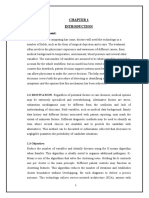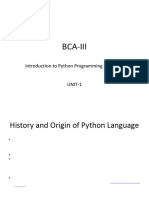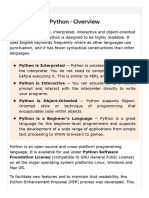Python
Uploaded by
cewek27686Python
Uploaded by
cewek27686Python has become a widely used language, now a days.
Some of the advantages of Python are as
follows:
1. Ease of Use - Python has a simple, concise, and straightforward syntax. A Python program looks a
lot like plain English and is highly readable. This makes Python programs easy to read and debug.
2. Versatility - Python is a flexible, general-purpose language that fully supports both procedural and
object-oriented programming. Due to its built-in and third-party packages, it is suitable for a wide
range of tasks.
3. No Compile Process - Python is an interpreted language and programs are automatically compiled
at run time. A program can be run as soon as it is written. There is no separate compiler, no time-
consuming compilation step, and no opaque compiler errors.
4. Automatic Memory Allocation - Python does not have pointers and developers do not have to
assign free space in memory. Python allocates memory automatically and a garbage collector
recycles memory from discarded objects.
5. Open Source and Free to Use - All Python releases are available for free under an open-source
license. Despite its many advantages, Python also has a few disadvantages.
These are: 1. Slow Speed - Python is much slower than more efficient languages like C and Java. As it
executes the code one line at a time, the speed of execution often is hampered. Where speed is
important for the project, Python cannot be used for coding.
2. Poor Memory Efficiency - To make it simple for the developer, Python needs a lot of memory
space; this can be problematic if you want to develop apps where you need to optimize memory.
3. Not Optimized for Database Access - Python has limitations with database access. As compared to
the popular technologies like JDBC and ODBC, Python's database access layer is found to be a bit
underdeveloped and primitive. However, it cannot be applied in the enterprises that need smooth
interaction of complex legacy data.
4. Weak in Mobile Computing - Python is used for backend programming; due to its high memory
usage and slow speed, it is generally not used for frontend programming or mobile app
development.
5. Version Incompatibility - Many of the frameworks and tools only work for specific versions and
cannot be used with others. For example, Python 2, considered the legacy version, has several
frameworks created especially for it; these are not compatible with Python 3, considered current and
futuristic.
You might also like
- Slidesgo Evaluating Python Analyzing the Advantages and Disadvantages of a Leading Programming Language 20241014144949rPScNo ratings yetSlidesgo Evaluating Python Analyzing the Advantages and Disadvantages of a Leading Programming Language 20241014144949rPSc8 pages
- The Best Python Programming Step-By-Step Beginners Guide Easily Master Software engineering with Machine Learning, Data Structures, Syntax, Django Object-Oriented Programming, and AI applicationFrom EverandThe Best Python Programming Step-By-Step Beginners Guide Easily Master Software engineering with Machine Learning, Data Structures, Syntax, Django Object-Oriented Programming, and AI applicationNo ratings yet
- Bird Species Identification Using Deep LearningNo ratings yetBird Species Identification Using Deep Learning74 pages
- The forest was alive with the sound of rustling leaves and the occasional snap of a twig underfootNo ratings yetThe forest was alive with the sound of rustling leaves and the occasional snap of a twig underfoot3 pages
- Module 1 Introduction To Python - AssignmentNo ratings yetModule 1 Introduction To Python - Assignment6 pages
- Chapter - 1 Getting Started With PythonNo ratings yetChapter - 1 Getting Started With Python10 pages
- Industrial Training Report (Harsh Raj Chouhan)No ratings yetIndustrial Training Report (Harsh Raj Chouhan)15 pages
- LEARN PYTHON PROGRAMMING: A Comprehensive Guide for Beginners to Master Python Programming (2024)From EverandLEARN PYTHON PROGRAMMING: A Comprehensive Guide for Beginners to Master Python Programming (2024)No ratings yet
- Python Language advantages and applicationsNo ratings yetPython Language advantages and applications9 pages
- Python for Beginners: The Dummies' Guide to Learn Python Programming. A Practical Reference with Exercises for Newbies and Advanced Developers: Python Programming, #1From EverandPython for Beginners: The Dummies' Guide to Learn Python Programming. A Practical Reference with Exercises for Newbies and Advanced Developers: Python Programming, #1No ratings yet
- Practical Guide to Python: From Basics to Advanced ProgrammingFrom EverandPractical Guide to Python: From Basics to Advanced ProgrammingNo ratings yet



























































